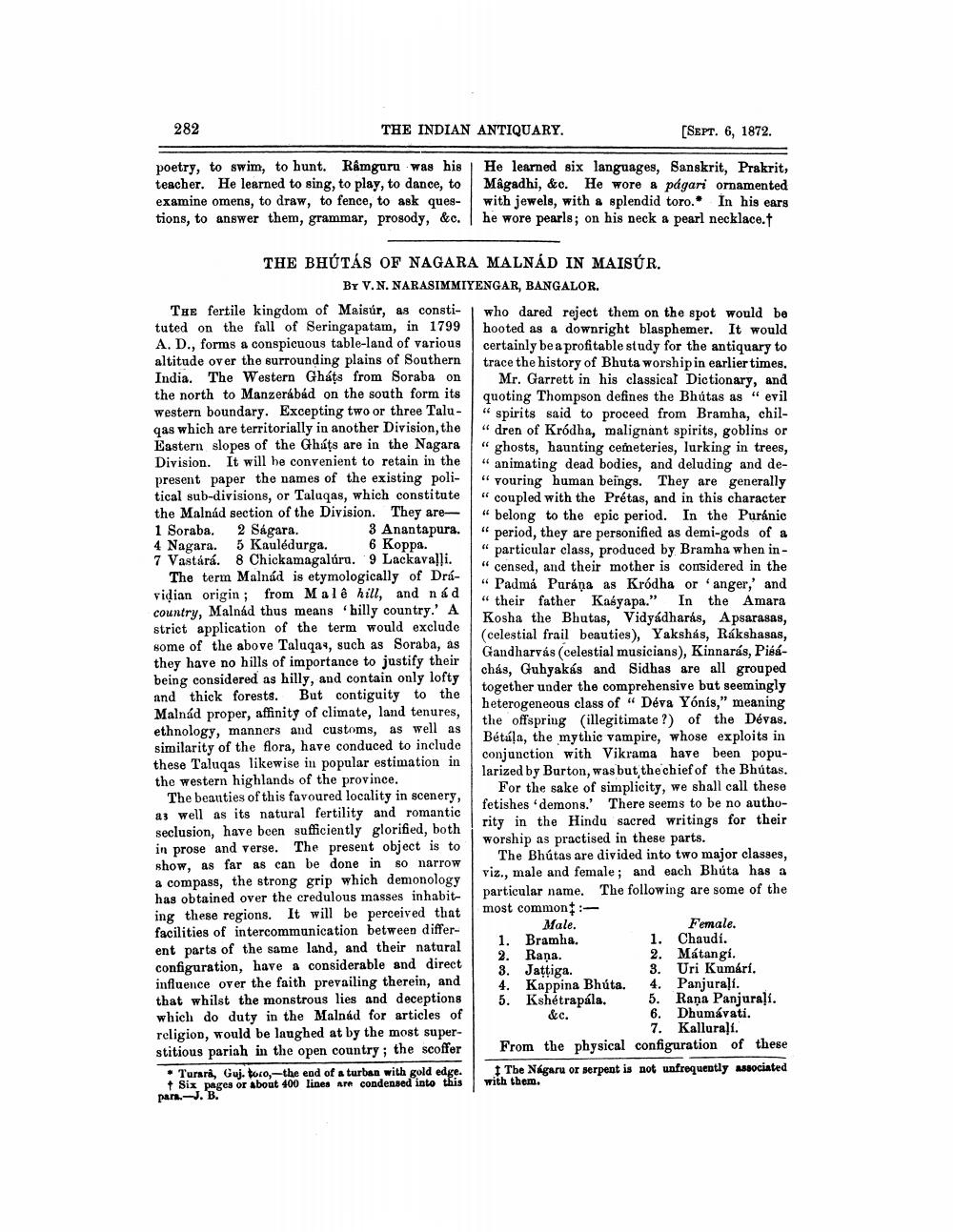________________
282
THE INDIAN ANTIQUARY.
[SEPT. 6, 1872.
poetry, to swim, to hunt. Râmguru was his teacher. He learned to sing, to play, to dance, to examine omens, to draw, to fence, to ask questions, to answer them, grammar, prosody, &c.
He learned six languages, Sanskrit, Prakrit, Mâgadhi, &c. He wore a pagari ornamented with jewels, with a splendid toro. In his ears he wore pearls; on his neck a pearl necklace.
THE BHÚTÁS OF NAGARA MALNÁD IN MAISÚR.
BY V.N. NARASIMMIYENGAR, BANGALOR. THE fertile kingdom of Maisúr, as consti- who dared reject them on the spot would be tuted on the fall of Seringapatam, in 1799 hooted as a downright blasphemer. It would A. D., forms a conspicuous table-land of various certainly be a profitable study for the antiquary to altitude over the surrounding plains of Southern
trace the history of Bhuta worshipin earlier times. India. The Western Gháts from Soraba on Mr. Garrett in his classical Dictionary, and the north to Manzerábád on the south form its quoting Thompson defines the Bhútas as "evil Western boundary. Excepting two or three Talu- " spirits said to proceed from Bramha, chilqas which are territorially in another Division, the
"dren of Kródha, malignant spirits, goblins or Eastern slopes of the Gháts are in the Nagara
"ghosts, haunting cemeteries, lurking in trees, Division. It will he convenient to retain in the "animating dead bodies, and deluding and depresent paper the names of the existing poli- "vouring human beings. They are generally tical sub-divisions, or Talaqas, which constitute
"coupled with the Prétas, and in this character the Malnád section of the Division. They are- " belong to the epic period. In the Puránic 1 Soraba. 2 Ságara.
3 Anantapura. "period, they are personified as demi-gods of a 4 Nagara. 5 Kaulédurga. 6 Koppa.
" particular class, produced by Bramha when in7 Vastárá. 8 Chickamagaluru. 9 Lackavalli.
"censed, and their mother is considered in the The term Malnád is etymologically of Drá
" Padma Puráņa as Kródha or anger, and vidian origin; from Malê hill, and nád
" their father Kasyapa." country, Malnád thus means hilly country.' A
In the Amara
Kosha the Bhutas, Vidyadharás, Apsarasas, strict application of the term would exclude
(celestial frail beauties), Yakshas, Rákshasas, some of the above Talaqas, such as Soraba, as
Gandharvás (celestial musicians), Kinnarás, Pisáthey have no hills of importance to justify their
chás, Guhyakás and Sidhas are all grouped being considered as hilly, and contain only lofty and thick forests. But contiguity to the
together under the comprehensive but seemingly
heterogeneous class of " Déva Yónis," meaning Malnád proper, affinity of climate, land tenures,
the offspring illegitimate ?) of the Devas. ethnology, manners and customs, as well as
Bétala, the mythic vampire, whose exploits in similarity of the flora, have conduced to include
conjunction with Vikrama have been poputhese Taluqas likewise in popular estimation in
larized by Burton, was but the chief of the Bhútas. the western highlands of the province.
For the sake of simplicity, we shall call these The beauties of this favoured locality in scenery,
fetishes demons.' There seems to be no authoas well as its natural fertility and romantic
rity in the Hindu sacred writings for their seclusion, have been sufficiently glorified, both
worship as practised in these parts. in prose and verse. The present object is to show, as far as can be done in so narrow
The Bhútas are divided into two major classes,
viz., male and female; and each Bhúta has a a compass, the strong grip which demonology has obtained over the credulous masses inhabit
particular name. The following are some of the ing these regions. It will be perceived that most commont: facilities of intercommunication between differ
Male.
Female. 1. Bramha.
1. Chaudí. ent parts of the same land, and their natural
2. Raņa.
2. Mátangi. configuration, have a considerable and direct
3. Jattiga.
3. Uri Kumári, influence over the faith prevailing therein, and
4. Kappina Bhúta. 4. Panjurați. that whilst the monstrous lies and deceptions 5. Kshetrapála. 5. Rana Panjuraļi. which do duty in the Malnád for articles of
&c.
6. Dhumavati. religion, would be laughed at by the most super
7. Kallurali. stitious pariah in the open country; the scoffer From the physical configuration of these Turara, Guj. toro,--the end of a turban with gold edge. The Nagaru or serpent is not unfrequently associated
with them. t Six pages or about 400 lines are condensed into this
es or
pan




